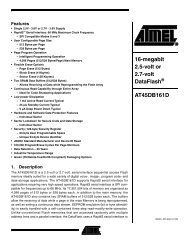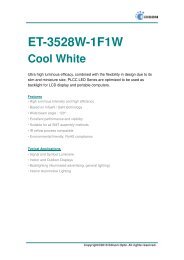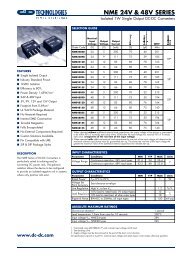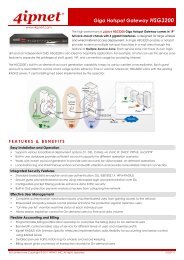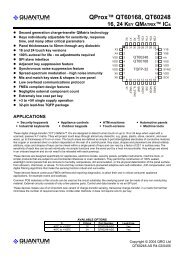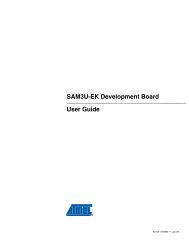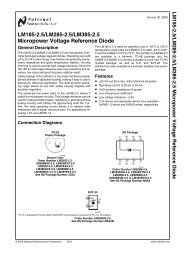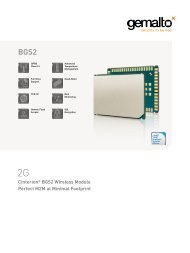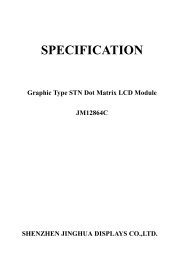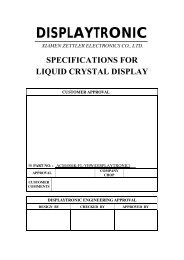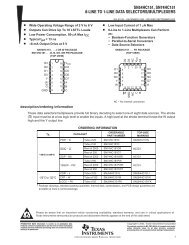Enhanced RS-232 Line Drivers and Receivers
Enhanced RS-232 Line Drivers and Receivers
Enhanced RS-232 Line Drivers and Receivers
Create successful ePaper yourself
Turn your PDF publications into a flip-book with our unique Google optimized e-Paper software.
+5V INPUT<br />
+5V INPUT<br />
7<br />
7<br />
V CC<br />
V CC<br />
TTL/CMOS OUTPUTS<br />
TTL/CMOS INPUTS<br />
T IN<br />
1<br />
T IN<br />
2<br />
R OUT<br />
1<br />
R OUT<br />
2<br />
Do not make<br />
connection to<br />
these pins<br />
2 400k Ω<br />
5<br />
T 1<br />
1 400k Ω<br />
18<br />
T 2<br />
3 4<br />
R 1<br />
5kΩ<br />
20 19<br />
R 2<br />
8 C +<br />
5kΩ<br />
1<br />
13<br />
C 1-<br />
C + 11<br />
2<br />
14<br />
V+<br />
C +<br />
15<br />
2<br />
12<br />
10<br />
V-<br />
C 2 -<br />
SP233ACP<br />
16<br />
17 V- GND GND C 2 -<br />
T OUT<br />
1<br />
T OUT<br />
2<br />
R IN<br />
1<br />
R IN<br />
2<br />
<strong>RS</strong>-<strong>232</strong> INPUTS<br />
<strong>RS</strong>-<strong>232</strong> OUTPUTS<br />
Connect on PCB<br />
Pin 11 to Pin 15<br />
Pin 10 to Pin 16<br />
Pin 12 to Pin 17<br />
Both Pins 6 <strong>and</strong> 9 to GND<br />
TTL/CMOS OUTPUTS<br />
TTL/CMOS INPUTS<br />
T IN<br />
1<br />
T IN<br />
2<br />
R OUT<br />
1<br />
R OUT<br />
2<br />
Do not make<br />
connection to<br />
these pins<br />
2 400k Ω<br />
5<br />
T 1<br />
1 400k Ω<br />
18<br />
T 2<br />
3 4<br />
R 1<br />
5k Ω<br />
20 19<br />
R 2<br />
13 C +<br />
5k Ω<br />
1<br />
14<br />
C 1-<br />
C + 12<br />
2<br />
8<br />
V+<br />
C +<br />
15<br />
2<br />
10<br />
11<br />
V-<br />
C 2 -<br />
SP233ACT<br />
17<br />
16<br />
V- GND GND C 2 -<br />
T OUT<br />
1<br />
T OUT<br />
2<br />
R IN<br />
1<br />
R IN<br />
2<br />
<strong>RS</strong>-<strong>232</strong> INPUTS<br />
<strong>RS</strong>-<strong>232</strong> OUTPUTS<br />
Connect on PCB<br />
Pin 12 to Pin 15<br />
Pin 11 to Pin 16<br />
Pin 10 to Pin 17<br />
Both Pins 6 <strong>and</strong> 9 to GND<br />
6<br />
9<br />
6<br />
9<br />
Figure 2. Typical Circuits using the SP233ACP <strong>and</strong> SP233ACT<br />
The instantaneous slew rate of the transmitter<br />
output is internally limited to a maximum of 30V/<br />
µs in order to meet the st<strong>and</strong>ards [EIA <strong>RS</strong>-<strong>232</strong>-F ].<br />
The transition region slew rate of these enhanced<br />
products is typically 10V/µs. The smooth transition<br />
of the loaded output from V OL<br />
to V OH<br />
clearly<br />
meets the monotonicity requirements of the st<strong>and</strong>ard<br />
[EIA <strong>RS</strong>-<strong>232</strong>-F].<br />
<strong>Receivers</strong><br />
The receivers convert <strong>RS</strong>-<strong>232</strong> input signals to<br />
inverted TTL signals. Since the input is usually<br />
from a transmission line, where long cable lengths<br />
<strong>and</strong> system interference can degrade the signal, the<br />
inputs have a typical hysteresis margin of 500mV.<br />
This ensures that the receiver is virtually immune<br />
to noisy transmission lines.<br />
The input thresholds are 0.8V minimum <strong>and</strong> 2.4V<br />
maximum, again well within the ±3V <strong>RS</strong>-<strong>232</strong><br />
requirements. The receiver inputs are also protected<br />
against voltages up to ±25V. Should an<br />
input be left unconnected, a 5KΩ pulldown resistor<br />
to ground will commit the output of the receiver<br />
to a high state.<br />
+5V INPUT<br />
10 µ F 6.3V<br />
+<br />
+5V INPUT<br />
10 µ F 6.3V<br />
+<br />
TTL/CMOS OUTPUTS<br />
TTL/CMOS INPUTS<br />
0.1 µ F +<br />
6.3V<br />
0.1 µ F +<br />
16V<br />
T IN<br />
1<br />
T IN<br />
2<br />
R OUT<br />
1<br />
R OUT<br />
2<br />
2<br />
4<br />
5<br />
6<br />
C +<br />
1<br />
C 1-<br />
C +<br />
2<br />
C 2-<br />
400k Ω<br />
12 15<br />
T 1<br />
400k Ω<br />
11 8<br />
T 2<br />
13 14<br />
R 1<br />
10 9<br />
R 2<br />
GND<br />
17<br />
V CC<br />
V+<br />
Charge Pump<br />
SP310A<br />
16<br />
0.1 µF<br />
10V<br />
3 +<br />
T OUT<br />
1<br />
T OUT<br />
2<br />
Figure 3. Typical Circuits using the SP310A <strong>and</strong> SP312A<br />
5k Ω<br />
5k Ω<br />
V-<br />
7<br />
18<br />
+<br />
R IN<br />
1<br />
R IN<br />
2<br />
*<br />
0.1 µF<br />
10V<br />
ON/OFF<br />
*The negative terminal of the V+ storage capacitor can be tied<br />
to either V CC or GND. Connecting the capacitor to V CC (+5V)<br />
is recommended.<br />
<strong>RS</strong>-<strong>232</strong> INPUTS<br />
<strong>RS</strong>-<strong>232</strong> OUTPUTS<br />
TTL/CMOS OUTPUTS<br />
TTL/CMOS INPUTS<br />
0.1 µ F +<br />
6.3V<br />
T IN<br />
1<br />
T IN<br />
2<br />
R OUT<br />
1<br />
R OUT<br />
2<br />
2<br />
4<br />
5<br />
0.1 µ F +<br />
16V 6<br />
EN<br />
C +<br />
1<br />
C 1-<br />
400k Ω<br />
12 15<br />
T 1<br />
400k Ω<br />
11 8<br />
T 2<br />
13 14<br />
R 1<br />
5kΩ<br />
10 9<br />
R 2<br />
1<br />
C +<br />
2<br />
C 2-<br />
GND<br />
17<br />
V CC<br />
V+<br />
Charge Pump<br />
5kΩ<br />
SP312A<br />
16<br />
V-<br />
0.1 µ F<br />
10V<br />
3 +<br />
7<br />
18<br />
+<br />
0.1 µ F<br />
10V<br />
T OUT<br />
1<br />
T OUT<br />
2<br />
R IN<br />
1<br />
R IN<br />
2<br />
*The negative terminal of the V+ storage capacitor can be tied<br />
to either V CC or GND. Connecting the capacitor to V CC (+5V)<br />
is recommended.<br />
*<br />
<strong>RS</strong>-<strong>232</strong> INPUTS<br />
<strong>RS</strong>-<strong>232</strong> OUTPUTS<br />
SHUTDOWN<br />
Date: 10/17/ 05 SP<strong>232</strong>A Series <strong>Enhanced</strong> <strong>RS</strong><strong>232</strong> Transceivers © Copyright 2005 Sipex Corporation<br />
5



